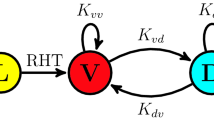Summary
Shifting from DD (continuous darkness) to LL (continuous light; red with maximum at 660 nm) affects the circadian cycle of Phaseolus as follows.
-
1.
The cycle which is directly influenced by this energy step (called the first cycle), is either shortened (“advance”) or lengthened (“delay”) as compared with the control cycle of about 28 hours (Fig. 1). The direction of this change, i.e., shortening or lengthening, is that which might be expected on the basis of the well known response curves. That means the influence of the single transition from DD to LL on this first cycle corresponds to the influence of light pulses in DD.
-
2.
After light-pulses in DD, in Phaseolus as in the case of other species, a shortened first cycle will be followed by a shortened second one, a lengthened first cycle by a lengthened second one (see Moser). After the step from DD to LL, however, a shortened first cycle is always followed by a lengthened second one (Fig. 2). A lengthened first cycle is followed either by a very short one (between about 10 and 18 hours), or by an extremely lengthened one (up to nearly 40 hours, Fig. 3).
The curves reveal that the extremely short cycles are due to the initiation of a new oscillation superimposed on the preceding one which is still completing its last peak (Fig. 4). The frequency of new initiations depends on the height of the energy-step and on the phase of its occurrence (Fig. 3, 6).
-
3.
The influence due to changing from LL to DD is rather slight (Fig. 5).
-
4.
The experiments favor the assumption that circadian oscillations follow the model of certain biological oscillations with higher frequencies: apparently we are dealing with a chain of all-or-none reactions separated by refractory periods. Advances are due to a premature breaking of the refractory period. Their frequency thus depends on the height of the energy step and on the time elapsed after the preceding peak (Fig. 6). Delays mean an extension of the reaction due to higher energy supply, that is, they are due to a longer lasting “climbing” towards a higher peak than the preceding one (Fig. 4a).
Similar content being viewed by others
Literatur
Bünning, E.: The physiological clock, revised sec. ed. Berlin-Heidelberg-New York: Springer 1967.
— u. I. Moser: Response-Kurven bei der circadianen Rhythmik von Phaseolus. Planta (Berl.) 69, 101–110 (1966).
Chandrashekaran, M. K.: Studies on phase-shifts in endogenous rhythms. I. Effects of light pulses on the eclosion rhythms in Drosophila pseudoobscura. Z. vergl. Physiol. 56, 154–162 (1967).
Engelmann, W.: Effect of light and dark pulses on the emergence rhythm of Drosophila pseudoobscura. Experientia (Basel) 22, 606 (1966).
Moser, I.: Phasenverschiebungen der endogenen Tagesrhythmik bei Phaseolus durch Temperatur- und Lichtintensitätsänderungen. Planta (Berl.) 58, 199–219 (1962).
Author information
Authors and Affiliations
Rights and permissions
About this article
Cite this article
Bünning, E., Moser, I. Weitere Versuche zur Lichtwirkung auf die circadiane Rhythmik von Phaseolus multiflorus . Planta 77, 99–107 (1967). https://doi.org/10.1007/BF00387447
Received:
Issue Date:
DOI: https://doi.org/10.1007/BF00387447




